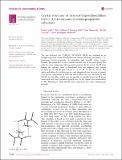Files in this item
Crystal structure of [tris(4,4′-bipyridine)]diium bis(1,1,3,3-tetracyano-2-ethoxypropenide) trihydrate
Item metadata
| dc.contributor.author | Setifi, Fatima | |
| dc.contributor.author | Valkonen, Arto | |
| dc.contributor.author | Setifi, Zouaoui | |
| dc.contributor.author | Nummelin, Sami | |
| dc.contributor.author | Touzani, Rachid | |
| dc.contributor.author | Glidewell, Christopher | |
| dc.date.accessioned | 2016-09-19T11:30:09Z | |
| dc.date.available | 2016-09-19T11:30:09Z | |
| dc.date.issued | 2016-09-01 | |
| dc.identifier | 245970894 | |
| dc.identifier | 3f4656c5-2780-4132-bb8f-1d69d2856d3e | |
| dc.identifier | 84999114820 | |
| dc.identifier | 000382301000005 | |
| dc.identifier.citation | Setifi , F , Valkonen , A , Setifi , Z , Nummelin , S , Touzani , R & Glidewell , C 2016 , ' Crystal structure of [tris(4,4′-bipyridine)]diium bis(1,1,3,3-tetracyano-2-ethoxypropenide) trihydrate ' , Acta Crystallographica Section E: Crystallographic Communications , vol. 72 , no. 9 , pp. 1246-1250 . https://doi.org/10.1107/S2056989016012160 | en |
| dc.identifier.issn | 2056-9890 | |
| dc.identifier.other | Bibtex: urn:072e2ae89365f151c386fa73d79e3f85 | |
| dc.identifier.uri | https://hdl.handle.net/10023/9524 | |
| dc.description | The authors acknowledge the Algerian MESRS (Ministère de l'Enseignement Supérieur et de la Recherche Scientifique), the DGRSDT (Direction Générale de la Recherche Scientifique et du Développement Technologique) and Université Ferhat Abbas Sétif 1 for financial support. | en |
| dc.description.abstract | The title hydrated salt, C30H26N62+·2C9H5N4O−·3H2O, was obtained as an unexpected product from the hydrothermal reaction between potassium 1,1,3,3-tetracyano-2-ethoxypropenide, 4,4′-bipyridine and iron(II) sulfate heptahydrate. The cation lies across a twofold rotation axis in the space group I2/a with the other components all in general positions. In the cation, the H atom linking the pyridine units is disordered over two adjacent sites having occupancies of 0.66 (4) and 0.36 (4), i.e. as N—H⋯N and N⋯H—N. The water molecules of crystallization are each disordered over two sets of atomic sites, having occupancies of 0.522 (6) and 0.478 (6) for one, and 0.34 (3) and 0.16 (3) for the other, and it was not possible to reliably locate the H atoms associated with these partial-occupancy sites. In the crystal, four independent C—H⋯N hydrogen bonds link the ionic components into a three-dimensional network. | |
| dc.format.extent | 5 | |
| dc.format.extent | 948890 | |
| dc.language.iso | eng | |
| dc.relation.ispartof | Acta Crystallographica Section E: Crystallographic Communications | en |
| dc.subject | Crystal structure | en |
| dc.subject | Hydrothermal synthesis | en |
| dc.subject | Polynitrile anions | en |
| dc.subject | Molecular structure | en |
| dc.subject | Hydrogen bonding | en |
| dc.subject | QD Chemistry | en |
| dc.subject | DAS | en |
| dc.subject.lcc | QD | en |
| dc.title | Crystal structure of [tris(4,4′-bipyridine)]diium bis(1,1,3,3-tetracyano-2-ethoxypropenide) trihydrate | en |
| dc.type | Journal article | en |
| dc.contributor.institution | University of St Andrews. School of Chemistry | en |
| dc.identifier.doi | https://doi.org/10.1107/S2056989016012160 | |
| dc.description.status | Peer reviewed | en |
This item appears in the following Collection(s)
Items in the St Andrews Research Repository are protected by copyright, with all rights reserved, unless otherwise indicated.

